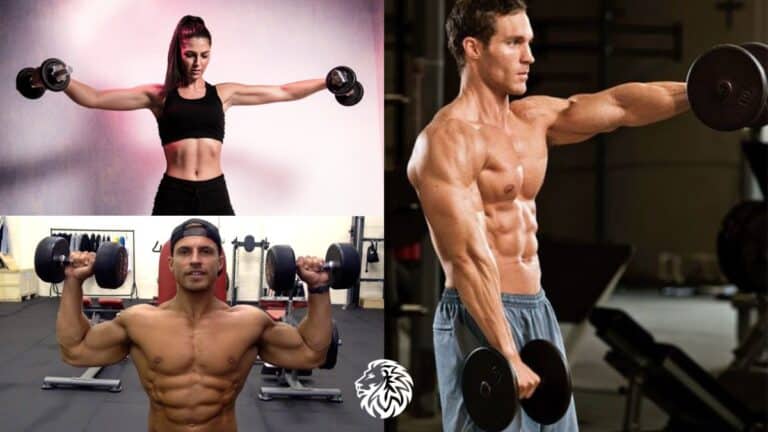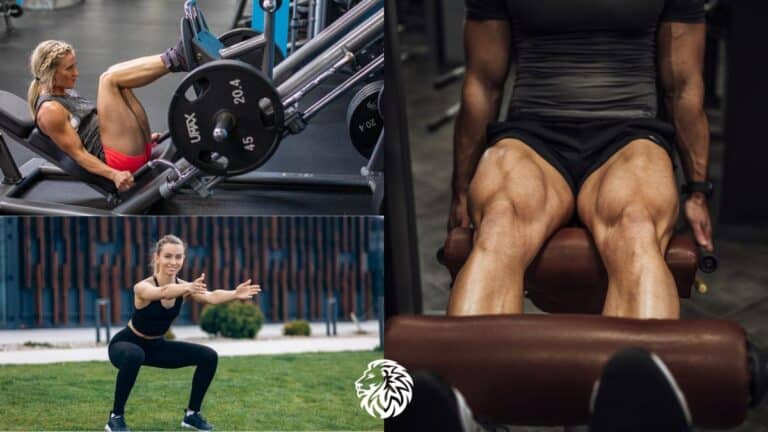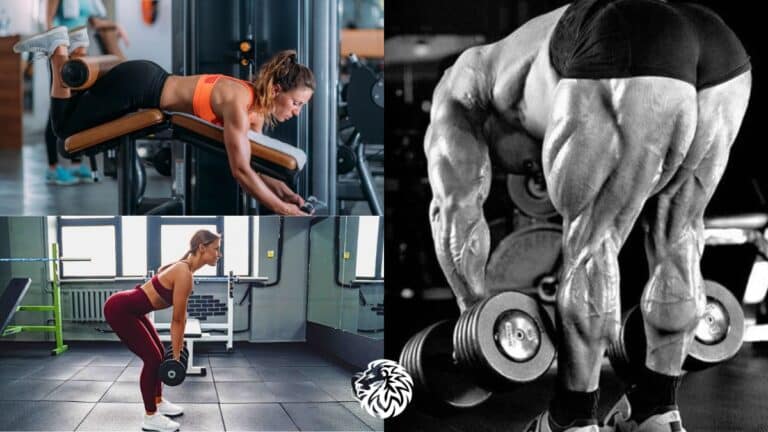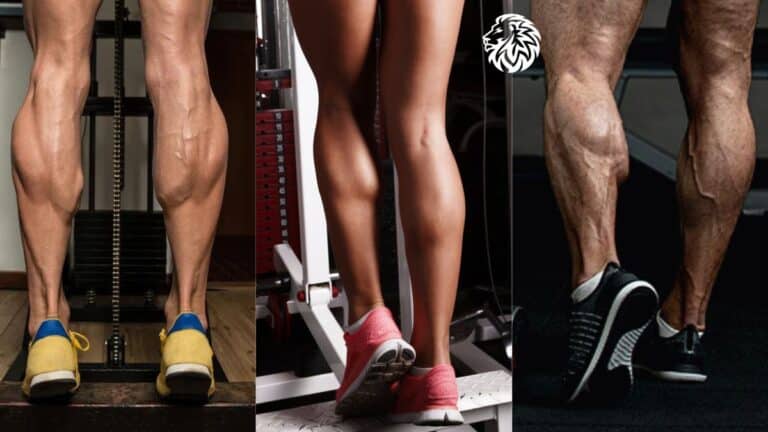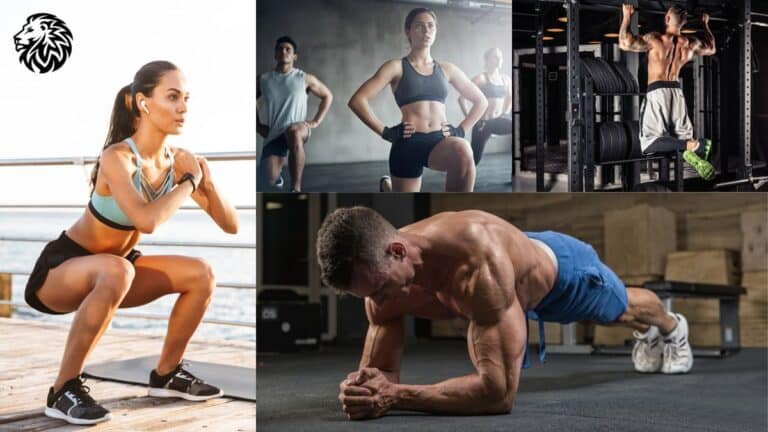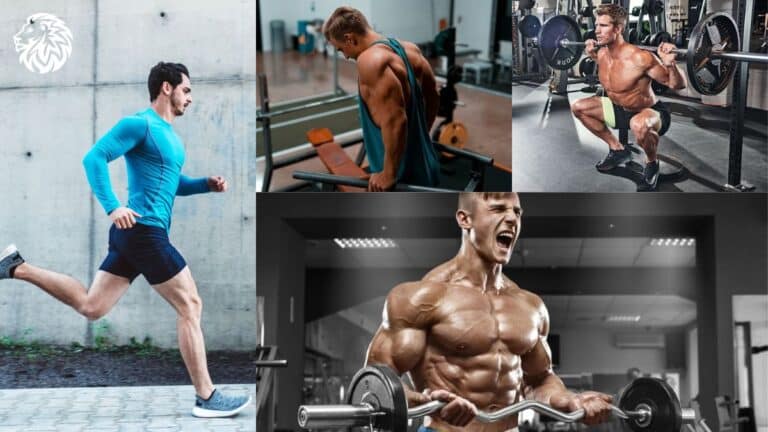Shoulder strength and size are crucial components of a well-rounded fitness regimen. Strong shoulders not only enhance the upper body’s aesthetic appeal, but they also play a pivotal role in various daily activities and sports. They are instrumental in lifting, pulling, and pushing motions, making them essential for functional strength. Additionally, well-developed shoulders contribute to a balanced physique, improve posture, and can help prevent injuries by supporting the joints and stabilizing the surrounding muscles.
In this article, we will delve into seven effective exercises specifically designed to target the shoulders. These exercises will cater to both strength and size development, ensuring a comprehensive approach to shoulder training. Each exercise has been chosen for its proven effectiveness in engaging the different muscles of the shoulder, including the deltoids and rotator cuff muscles. We’ll provide a detailed guide on how to perform these exercises correctly, along with tips to maximize their benefits. Whether you’re a beginner or an experienced fitness enthusiast, these exercises can be adapted to fit your skill level and help you achieve robust and aesthetically pleasing shoulders.
Anatomy of the Shoulder
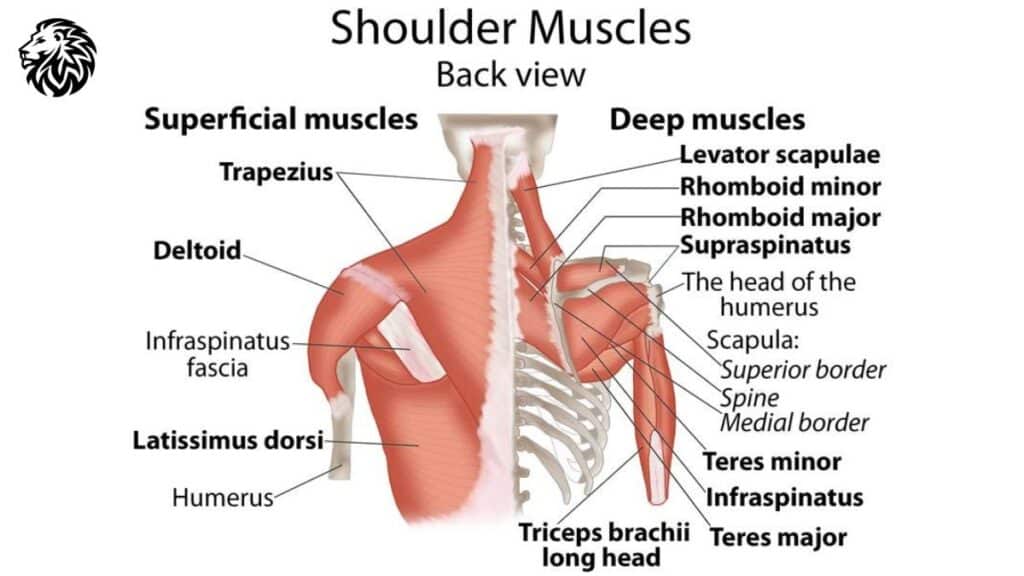
The shoulder is a complex and highly mobile joint, composed of several key muscles and structures. Understanding these components is essential for effective and safe shoulder training.
- Understanding the Shoulder Muscles
- Deltoids: The deltoids are the most prominent shoulder muscles, consisting of three distinct parts – the anterior (front), medial (middle), and posterior (rear) deltoids. Each part plays a unique role in shoulder movements.
- Rotator Cuff: A group of four smaller muscles (supraspinatus, infraspinatus, teres minor, and subscapularis) that stabilize the shoulder joint and facilitate various arm movements.
- Trapezius: This muscle extends from the neck to the mid-back, supporting the shoulder blade movements and upper back stability.
- Other Supporting Muscles: Muscles such as the serratus anterior and rhomboids also contribute to shoulder function, assisting in scapular motion and stability.
- Importance of Balanced Training
- Preventing Imbalances: Focusing equally on all parts of the deltoids and the supporting muscles is crucial. Neglecting any area can lead to imbalances, which may cause poor posture and increase injury risk.
- Enhancing Overall Functionality: A balanced shoulder workout ensures comprehensive development, enhancing not just the aesthetics but also the functional strength of the shoulders.
- Injury Prevention: Strengthening the rotator cuff and supporting muscles is key to preventing common shoulder injuries, particularly in movements involving overhead lifting.
- Improved Posture and Performance: Balanced shoulder development contributes to better posture, which is vital for overall spinal health. It also enhances performance in sports and daily activities that require upper body strength and stability.
In the following sections, we will explore exercises that target these crucial areas, ensuring a well-rounded approach to building shoulder strength and size.
7 Shoulder Exercises for Strength and Size
Exercise 1: Overhead Press
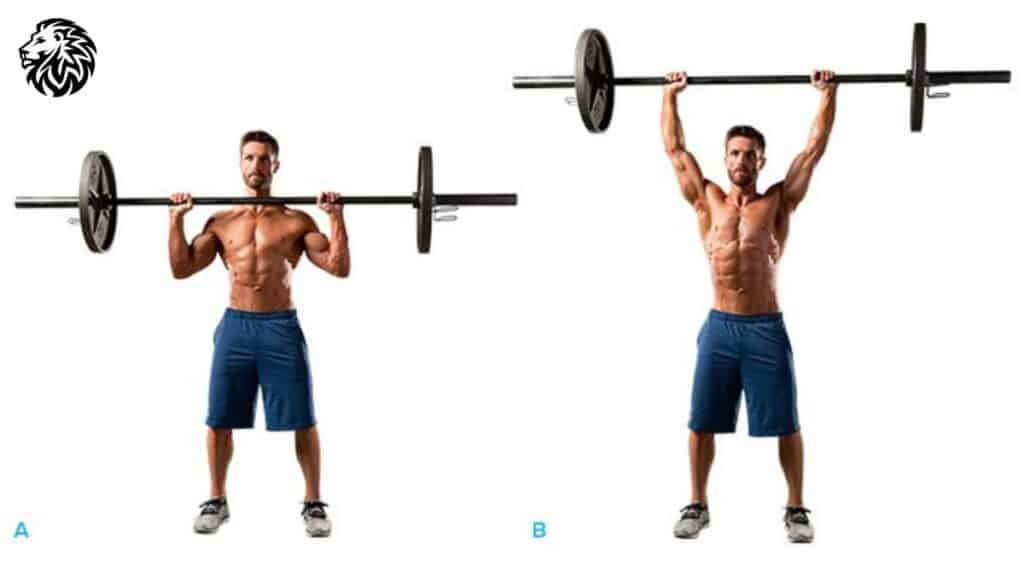
- Description and Benefits
- The Overhead Press, also known as the Shoulder Press, is a fundamental strength exercise that primarily targets the anterior and medial deltoids. It also engages the triceps, upper back, and core, making it an excellent compound movement for overall upper body strength.
- Key Benefits:
- Enhances shoulder strength and stability.
- Builds muscle mass in the deltoids.
- Improves functional strength for daily activities and sports that require pushing or lifting overhead.
- Contributes to better posture by strengthening the upper back muscles.
- Step-by-Step Guide
- Starting Position:
- Stand with your feet shoulder-width apart for stability.
- Hold a barbell or a pair of dumbbells at shoulder height, palms facing forward. Your grip should be just wider than shoulder-width.
- Brace your core and keep your spine neutral.
- Execution:
- Exhale and press the weight straight up overhead, extending your arms fully but without locking your elbows.
- Keep your head and chest up, and avoid arching your lower back.
- Pause at the top of the movement for a brief moment.
- Lowering the Weight:
- Inhale as you slowly lower the weight back to the starting position, at shoulder height.
- Ensure the movement is controlled to maximize muscle engagement.
- Repetitions:
- Perform 3-4 sets of 8-12 repetitions, depending on your fitness level and goals.
- Safety Tips:
- Start with a weight that allows you to maintain proper form.
- Avoid using momentum to lift the weight; the movement should be controlled and steady.
- Keep your core engaged throughout the exercise to protect your lower back.
- If you’re new to this exercise, consider practicing with a lighter weight or even without weight to get used to the motion.
- Starting Position:
The Overhead Press is a versatile exercise that can be performed with various equipment, such as barbells, dumbbells, or kettlebells, and can also be done while seated to focus more strictly on the shoulders.
Exercise 2: Lateral Raises
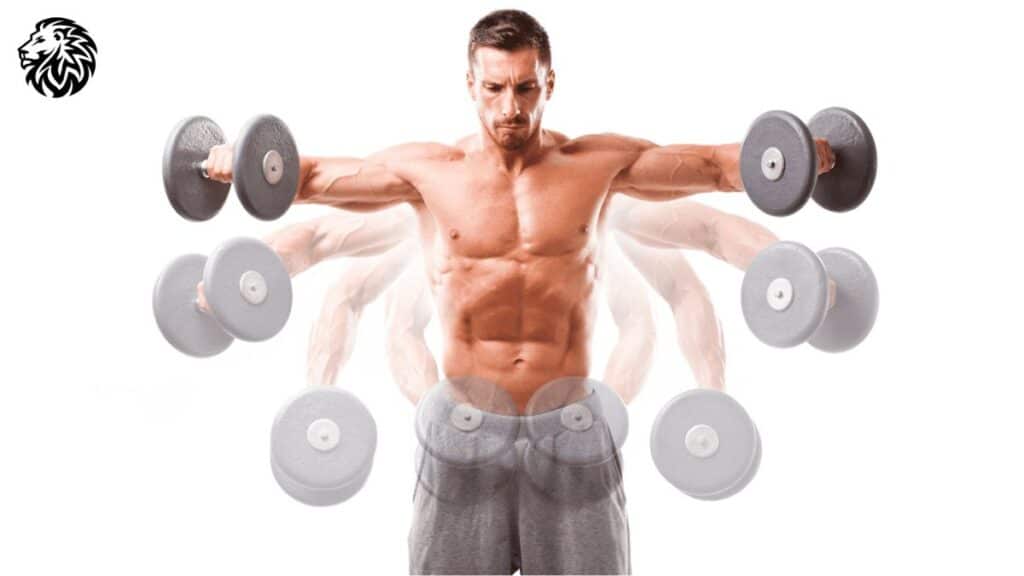
- Description and Benefits
- Lateral Raises are an isolation exercise specifically targeting the medial (middle) deltoids. They also engage the anterior deltoids and, to a lesser extent, the upper traps.
- Key Benefits:
- Strengthen and define the medial deltoids, contributing to broader, more pronounced shoulders.
- Improve shoulder mobility and stability.
- Enhance the aesthetic appearance by creating a more distinct shoulder cap.
- Beneficial for activities and sports requiring lateral arm movements.
- Step-by-Step Guide
- Starting Position:
- Stand with your feet hip-width apart, holding a dumbbell in each hand with your palms facing your body.
- Keep a slight bend in your elbows to reduce strain on the joints.
- Engage your core and maintain a straight back.
- Execution:
- Exhale and lift the dumbbells out to the sides, keeping your elbows slightly bent and leading with your elbows.
- Raise the weights until your arms are parallel to the floor, keeping the movement smooth and controlled.
- Pause briefly at the top of the movement.
- Lowering the Weights:
- Inhale as you slowly lower the dumbbells back to your sides.
- Maintain control throughout the descent to maximize muscle engagement.
- Repetitions:
- Perform 3-4 sets of 10-15 repetitions. Lateral Raises are typically done with lighter weights and higher reps due to the nature of the movement and the smaller muscle group involved.
- Safety Tips:
- Avoid swinging the weights or using momentum; the focus should be on controlled, deliberate movements.
- Keep your movements slow and controlled to prevent shoulder injuries.
- Do not lift the dumbbells higher than shoulder level to avoid unnecessary strain on the shoulder joint.
- If you experience any shoulder pain during this exercise, consider reducing the weight or consulting a fitness professional for form assessment.
- Starting Position:
Lateral Raises are a staple exercise for shoulder development and can be varied by using resistance bands, cable machines, or performing them in a seated position to reduce body momentum and increase muscle activation.
Exercise 3: Front Raises
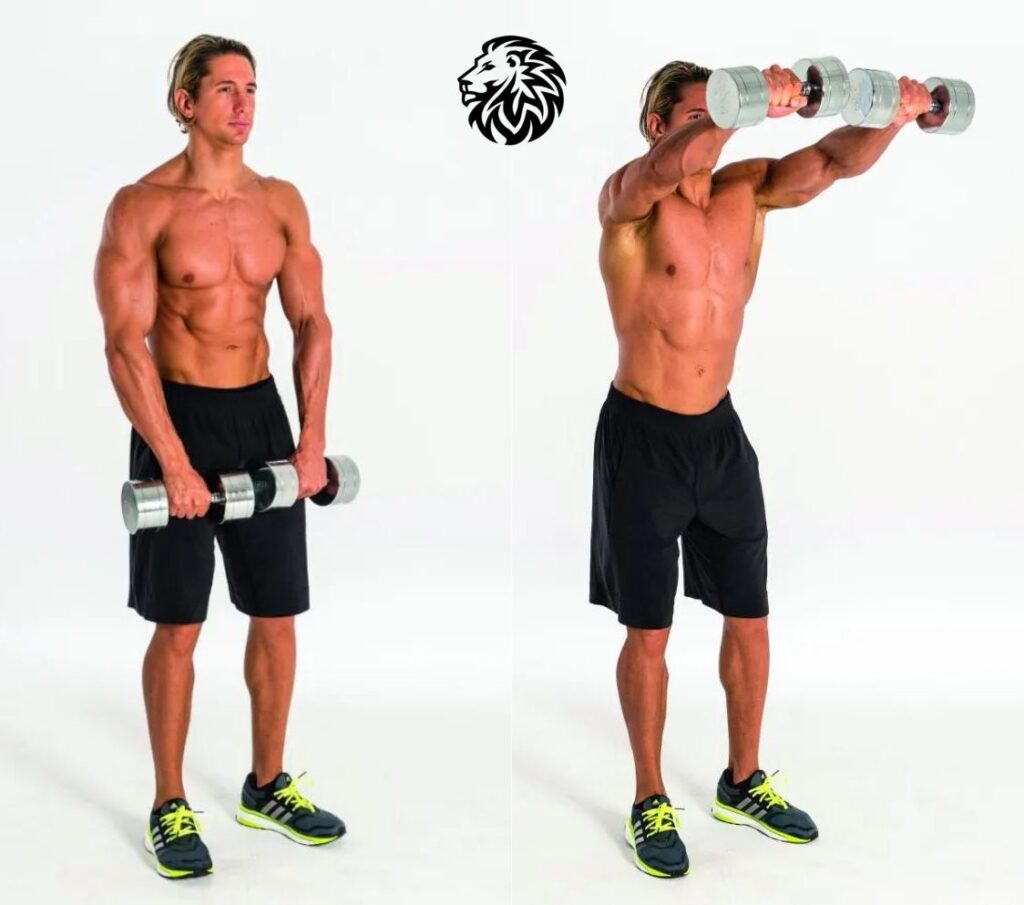
- Description and Benefits
- Front Raises primarily target the anterior (front) deltoids. They also engage the upper chest and the serratus anterior to a lesser extent.
- Key Benefits:
- Strengthen and define the front part of the shoulder.
- Enhance the visual appeal of the shoulder by contributing to a balanced, rounded shape.
- Improve functional strength for activities involving lifting or pushing in front of the body.
- Complement other shoulder exercises for a well-rounded shoulder workout.
- Step-by-Step Guide
- Starting Position:
- Stand with your feet shoulder-width apart, holding a dumbbell in each hand in front of your thighs. Palms should face your body.
- Keep a slight bend in your elbows to protect the joints.
- Engage your core and maintain a straight back.
- Execution:
- Exhale and raise one dumbbell in front of you, keeping your arm straight or slightly bent.
- Lift the weight to shoulder height, keeping the movement controlled.
- Pause briefly at the top of the movement.
- Lowering the Weight:
- Inhale as you slowly lower the dumbbell back to the starting position.
- Alternate arms, or raise both arms simultaneously for added intensity.
- Repetitions:
- Perform 3-4 sets of 10-15 repetitions. Like Lateral Raises, Front Raises are typically performed with lighter weights and higher reps.
- Safety Tips:
- Avoid swinging the weights; the lift should be smooth and controlled.
- Do not lift the dumbbells too high to prevent excessive strain on the shoulder joint.
- If using both arms simultaneously, be extra cautious with the weight selection to maintain proper form.
- Keep your movements controlled to prevent momentum from taking over, ensuring that the shoulder muscles are doing the work.
- Starting Position:
Front Raises are versatile and can be performed with various equipment, including dumbbells, barbells, kettlebells, or resistance bands. They can also be done in a seated position to minimize the potential for body sway or momentum use.
Exercise 4: Upright Rows
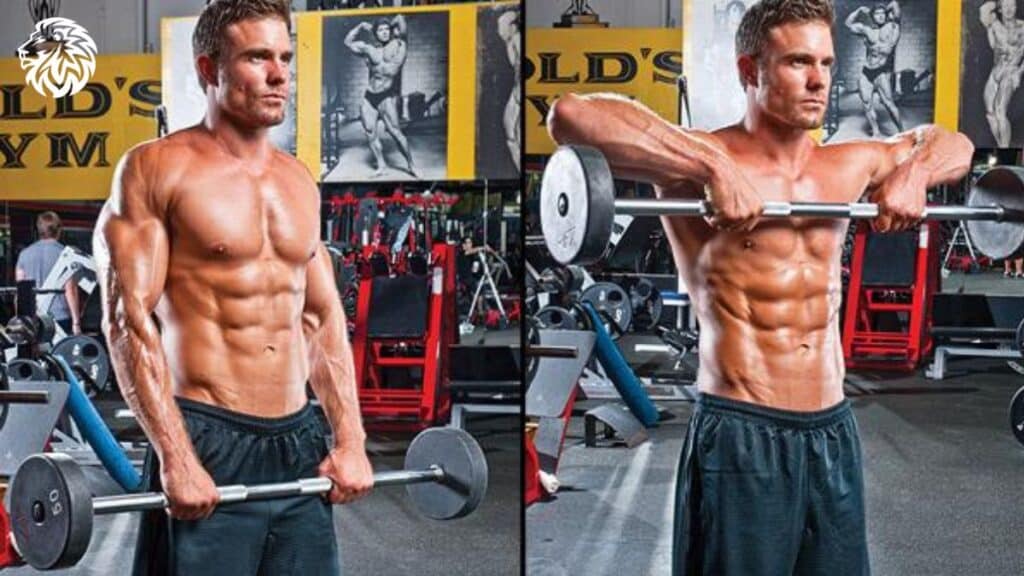
- Description and Benefits
- Upright Rows are a compound exercise that targets multiple muscles in the upper body, primarily the trapezius, deltoids (especially the lateral and anterior heads), and to some extent, the biceps.
- Key Benefits:
- Develops the trapezius and shoulder muscles, contributing to a more muscular upper body appearance.
- Enhances shoulder width and upper back strength.
- Improves functional strength for pulling motions.
- Can be varied with different equipment to suit different fitness levels and preferences.
- Step-by-Step Guide
- Starting Position:
- Stand with your feet shoulder-width apart.
- Hold a barbell or dumbbells in front of you with an overhand grip, hands slightly narrower than shoulder-width apart.
- Keep your back straight and core engaged.
- Execution:
- Exhale and lift the weights straight up by elevating your elbows. Your hands should stay close to your body.
- Lift the weights to chest level, with your elbows pointing out to the sides and higher than your wrists.
- Keep your wrists straight throughout the movement.
- Lowering the Weights:
- Inhale as you slowly lower the weights back to the starting position.
- Maintain a controlled motion to maximize muscle engagement and reduce the risk of injury.
- Repetitions:
- Perform 3-4 sets of 8-12 repetitions. Adjust the weight to maintain proper form throughout all sets.
- Safety Tips:
- Start with a light weight to ensure proper form and prevent shoulder or wrist injuries.
- Avoid lifting the weights too high, which can put unnecessary strain on the shoulder joint.
- Keep the lift controlled; avoid jerking or using momentum to lift the weight.
- If you have a history of shoulder or wrist issues, consult with a fitness professional before including this exercise in your routine.
- Starting Position:
Upright Rows can be performed with a variety of equipment, including barbells, dumbbells, kettlebells, or a cable machine. Adjusting the grip width can also alter the focus on different muscle groups and reduce strain on the wrists and shoulders.
Exercise 5: Reverse Flyes
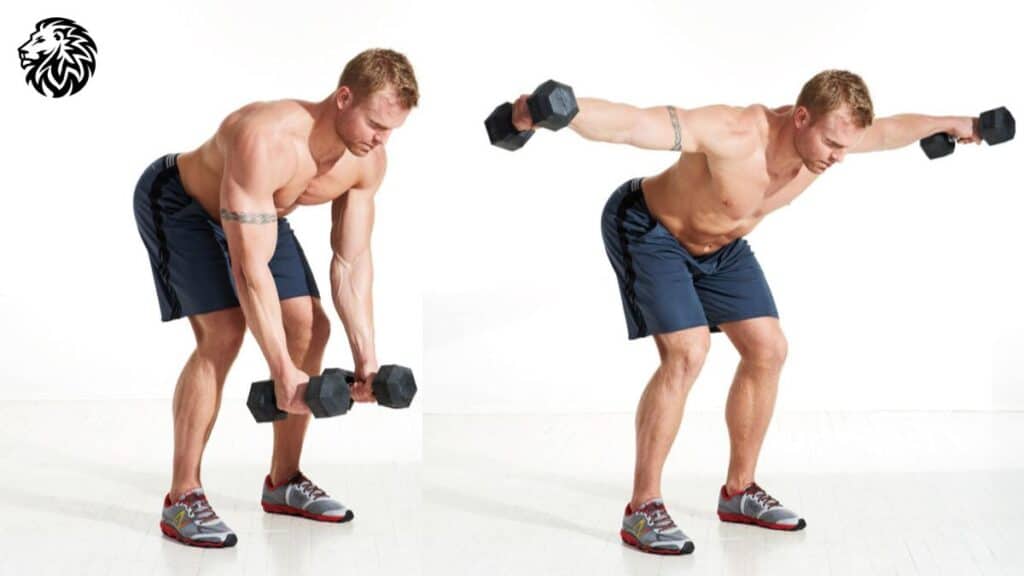
- Description and Benefits
- Reverse Flyes primarily target the posterior deltoids (rear shoulders), as well as the rhomboids and trapezius in the upper back.
- Key Benefits:
- Strengthens and defines the rear deltoids, promoting balanced shoulder development.
- Enhances posture by strengthening the upper back muscles.
- Reduces the risk of shoulder injuries by providing stability to the shoulder joint.
- Complements other shoulder exercises for overall shoulder health and aesthetics.
- Step-by-Step Guide
- Starting Position:
- Stand with your feet shoulder-width apart, holding a dumbbell in each hand.
- Hinge at your hips and bend your knees slightly, keeping your back flat and parallel to the floor.
- Extend your arms down in front of you, palms facing each other, with a slight bend in the elbows.
- Execution:
- Exhale and lift the dumbbells out to the sides, keeping your elbows slightly bent and squeezing your shoulder blades together at the top of the movement.
- Raise the weights until your arms are parallel to the floor.
- Pause briefly at the top of the movement.
- Lowering the Weights:
- Inhale as you slowly lower the dumbbells back to the starting position.
- Maintain control throughout the descent to maximize muscle engagement.
- Repetitions:
- Perform 3-4 sets of 10-15 repetitions. Light to moderate weights are typically used for this exercise.
- Safety Tips:
- Keep your back straight and avoid rounding your spine during the movement.
- Avoid using momentum; the movement should be slow and controlled.
- Do not lift the weights too high, as this can put undue stress on the shoulder joint.
- If you experience back discomfort, try performing this exercise in a seated or prone position for additional support.
- Starting Position:
Reverse Flyes are a crucial exercise for targeting the often-neglected rear deltoids and upper back. They can be performed with various equipment like dumbbells, resistance bands, or on a reverse fly machine. The exercise can also be done in a bent-over, seated, or prone (lying face down on a bench) position, each offering different benefits and levels of difficulty.
Exercise 6: Arnold Press
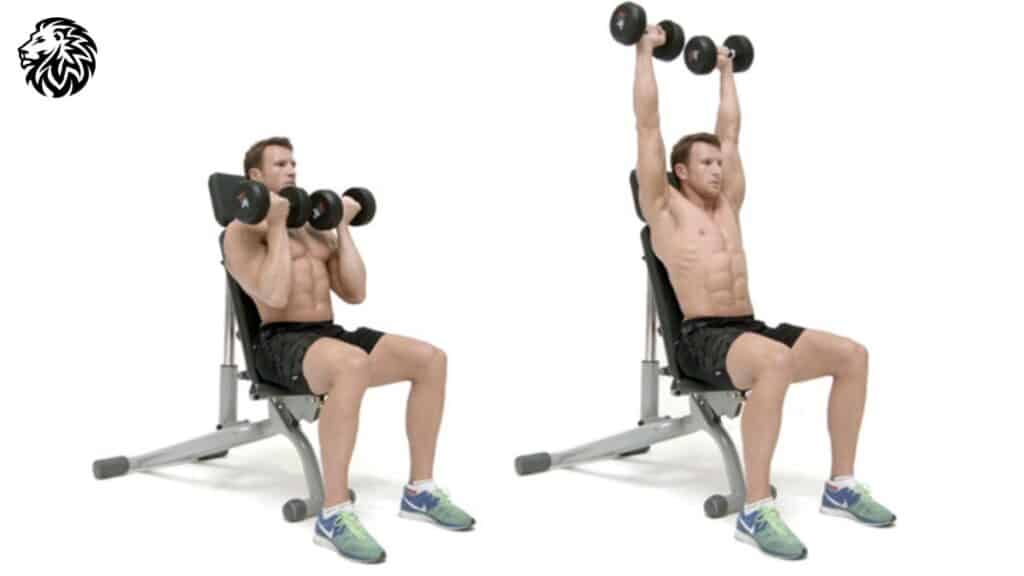
- Description and Benefits
- The Arnold Press, named after Arnold Schwarzenegger, is a variation of the traditional shoulder press that incorporates rotation, targeting multiple aspects of the deltoids.
- Key Benefits:
- Works all three heads of the deltoids (anterior, medial, and posterior) for comprehensive shoulder development.
- Enhances shoulder mobility and flexibility due to the rotational movement.
- Builds functional strength applicable to various sports and daily activities.
- Engages the upper back and triceps, contributing to overall upper body strength.
- Step-by-Step Guide
- Starting Position:
- Sit on a bench with back support or stand with feet shoulder-width apart.
- Start with dumbbells at shoulder height, palms facing towards you (like the top of a bicep curl).
- Keep your back straight and core engaged.
- Execution:
- As you press the dumbbells up, rotate your arms so that your palms face forward at the top of the movement.
- Extend your arms fully, but don’t lock out your elbows.
- At the top of the press, your palms should face away from you, and the dumbbells should be directly above your shoulders.
- Lowering the Weights:
- Reverse the motion by rotating your arms back to the starting position as you lower the dumbbells.
- Inhale as you return to the starting position with palms facing towards you.
- Repetitions:
- Perform 3-4 sets of 8-12 repetitions. Select a weight that allows you to maintain proper form throughout the exercise.
- Safety Tips:
- Start with lighter weights to master the rotational movement without straining your shoulders.
- Keep the movement controlled, especially during the rotation, to avoid jerking or swinging the weights.
- Ensure that your shoulders and back are stable throughout the exercise to prevent injury.
- If you have existing shoulder issues, be cautious with this exercise and consider consulting with a fitness professional.
- Starting Position:
The Arnold Press is an advanced shoulder exercise that provides a dynamic challenge to the shoulder muscles. It can be done with dumbbells or adapted to use with a resistance band or cable machine for variation.
Exercise 7: Shrugs
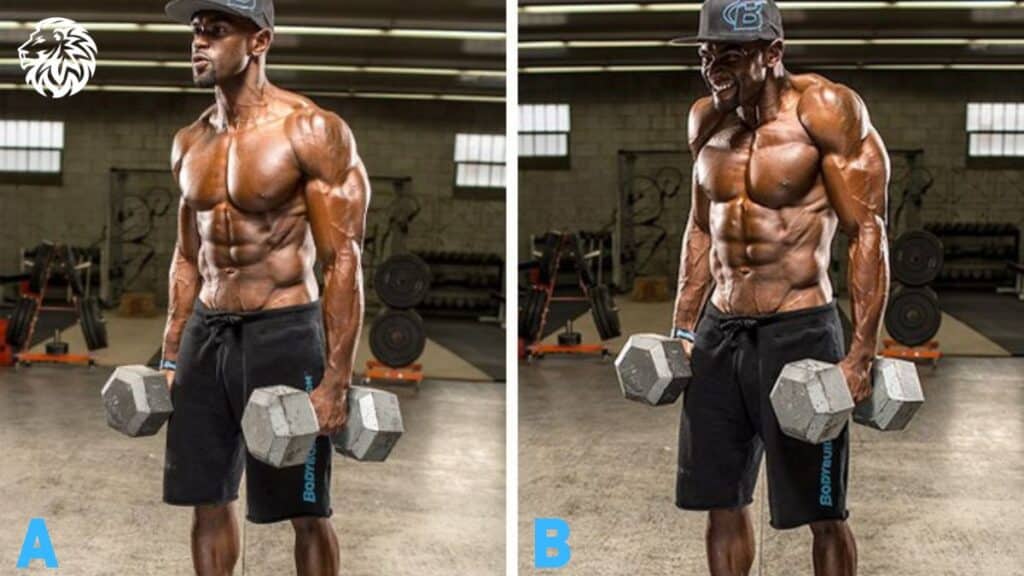
- Description and Benefits
- Shrugs primarily target the trapezius muscles in the upper back and neck area. They also engage the levator scapulae and to a lesser extent, the deltoids.
- Key Benefits:
- Develops and strengthens the upper trapezius muscles, contributing to upper back strength and neck stability.
- Enhances the aesthetic appearance of the upper back and shoulders.
- Supports better posture and shoulder health.
- Useful for improving grip strength, as they require holding weights for an extended period.
- Step-by-Step Guide
- Starting Position:
- Stand with your feet shoulder-width apart, holding a dumbbell in each hand at your sides. Alternatively, a barbell in front of you can be used.
- Keep your arms straight, and your back upright.
- Execution:
- Lift your shoulders straight up towards your ears in a shrugging motion, keeping your arms and back straight.
- Exhale as you elevate your shoulders as high as possible.
- Squeeze your trapezius muscles at the top of the movement for maximum engagement.
- Lowering the Weights:
- Inhale and slowly lower your shoulders back to the starting position.
- Ensure the movement is controlled to avoid any jerking or bouncing.
- Repetitions:
- Perform 3-4 sets of 10-15 repetitions. This exercise is often done with heavier weights, but it’s crucial to start with a weight that allows proper form.
- Safety Tips:
- Avoid rolling your shoulders forward or backward as this can lead to strain and injury.
- Keep the movement vertical without tilting your head forward or backward.
- Do not use excessive weight that forces you to jerk or bounce the weights up, as this can cause neck and spine injuries.
- Maintain a neutral spine and avoid arching your back during the exercise.
- Starting Position:
Shrugs are a simple yet effective exercise for developing the traps and can be easily incorporated into any upper body or shoulder workout routine. They can be performed with a variety of equipment including dumbbells, barbells, kettlebells, or even a trap bar, offering flexibility in training and progression.
Incorporating These Exercises into Your Routine

- Tips for Creating a Balanced Workout
- Diversify Your Exercises: Include a mix of these shoulder exercises in your routine to target all parts of the deltoids and the upper back. This approach helps in achieving balanced development.
- Combine with Other Muscle Groups: While focusing on shoulders, also incorporate exercises for other muscle groups to maintain overall body balance.
- Sequence Matters: Start with compound movements like Overhead Presses and Arnold Presses when you’re fresh, as they require more energy and coordination. Follow up with isolation exercises like Lateral Raises, Front Raises, Reverse Flyes, and Shrugs.
- Consider Supersets: To increase intensity and efficiency, pair exercises in supersets (e.g., doing a set of Lateral Raises immediately followed by Front Raises).
- Recommended Frequency and Volume
- Frequency: Shoulder workouts can be done 1-2 times per week depending on your overall program. Ensure there is enough recovery time between sessions, as the shoulders are often indirectly worked on chest and back days.
- Volume: A typical approach could be 3-4 sets of each exercise, with 8-12 reps for compound movements and 10-15 reps for isolation movements. Adjust the volume based on your fitness level and goals.
- Progressive Overload: Gradually increase the weight or the number of repetitions over time to continually challenge your muscles.
- Recovery: Pay attention to rest and recovery. Shoulders can be susceptible to overuse injuries, so ensure you’re not overtraining and allow adequate recovery.
- Additional Considerations
- Warm-Up and Cool Down: Begin with a general warm-up followed by dynamic shoulder stretches. End your workout with cool-down exercises and static stretching to aid recovery and flexibility.
- Listen to Your Body: Shoulders are a complex joint prone to injuries. Pay attention to any pain or discomfort and modify exercises as needed.
- Consistency is Key: Regular training combined with proper nutrition and rest is essential for gaining strength and size in your shoulders.
By following these guidelines, you can effectively incorporate these shoulder exercises into your routine for optimal development and performance. Remember, individual needs and goals vary, so feel free to adjust the recommendations to suit your personal fitness journey.
Safety and Injury Prevention
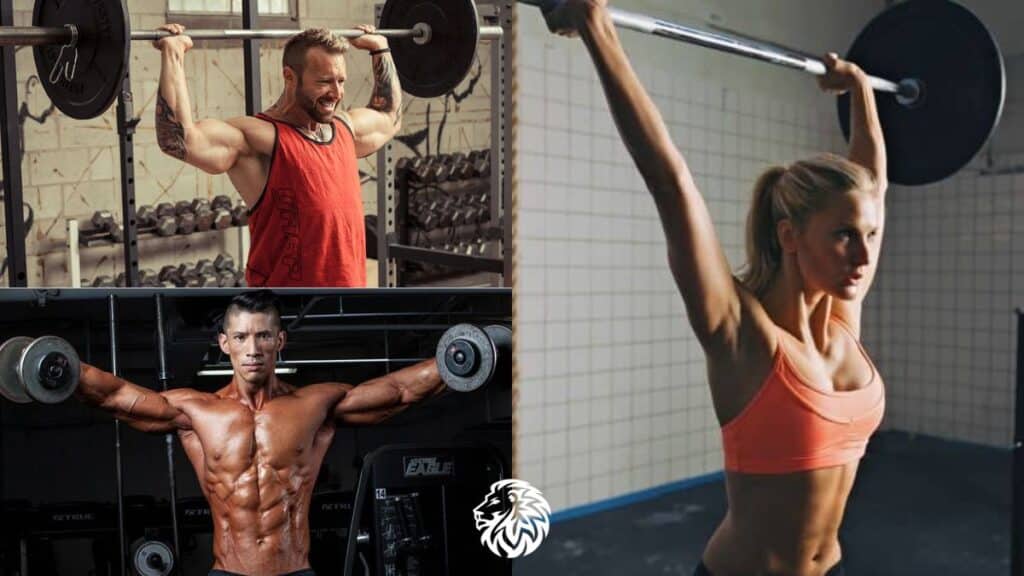
- Warm-Up and Cool-Down Techniques
- Warm-Up:
- Begin with 5-10 minutes of cardiovascular exercise (like jogging or jumping jacks) to increase blood flow.
- Follow with dynamic stretches focusing on the shoulders, neck, and upper back, such as arm circles, arm swings, and shoulder rolls.
- Perform a few light sets of each exercise with minimal weight to prepare the muscles and joints.
- Cool-Down:
- Conclude your workout with 5-10 minutes of light cardiovascular exercise to gradually lower your heart rate.
- Engage in static stretching, focusing on the deltoids, triceps, upper back, and chest. Hold each stretch for 15-30 seconds to improve flexibility and aid recovery.
- Warm-Up:
- Common Mistakes to Avoid
- Lifting Too Heavy, Too Soon: Progressively increase weight to avoid overloading the shoulder joint.
- Poor Form: This can lead to ineffective training and increased injury risk. Ensure correct form and technique before increasing weight.
- Neglecting Opposing Muscle Groups: Focusing too much on the front of the shoulders and neglecting the rear can lead to imbalances and poor posture. Balance your shoulder workouts.
- Skipping Warm-Up and Cool-Down: These are essential for preparing the muscles for exercise and preventing stiffness and injury.
- Overtraining: Shoulders can easily be overworked, especially since they’re involved in many upper body exercises. Allow adequate rest and recovery.
- Ignoring Pain: Shoulder pain can be a sign of injury or strain. If you experience persistent pain, it’s important to rest and consult a healthcare professional.
- Additional Safety Tips
- Use a Spotter for Heavy Lifts: When attempting heavy overhead presses, having a spotter can provide safety and confidence.
- Stay Hydrated: Proper hydration is essential for muscle function and injury prevention.
- Include Rotator Cuff Exercises: Strengthening the rotator cuff muscles is key for shoulder stability and injury prevention.
- Mind Your Posture: Even outside the gym, be mindful of your posture to support overall shoulder health.
By incorporating these safety and injury prevention strategies into your routine, you can enjoy a productive shoulder workout while minimizing the risk of injury. Remember, consistency in both exercise and safety practices is key to long-term success and shoulder health.
Conclusion
In summary, this article has provided a comprehensive guide to seven effective shoulder exercises for strength and size. Each exercise targets different aspects of the shoulder muscles, ensuring a well-rounded approach to shoulder development. Here’s a quick recap of the key points:
- Variety of Exercises: Incorporating a mix of compound and isolation exercises like Overhead Press, Lateral Raises, Front Raises, Upright Rows, Reverse Flyes, Arnold Press, and Shrugs ensures all areas of the shoulder are worked.
- Balanced Training: It’s important to balance these exercises with workouts for other muscle groups and ensure equal attention to all parts of the shoulder for symmetry and injury prevention.
- Proper Form and Technique: Emphasizing correct form and technique in each exercise is crucial for maximizing effectiveness and minimizing the risk of injury.
- Warm-Up and Cool-Down: Proper warm-up and cool-down routines, including dynamic and static stretching, are vital for preparing the muscles for the workout and aiding in recovery post-exercise.
- Consistency and Progression: Regular practice, coupled with gradual increases in intensity and weight, is key to developing shoulder strength and size.
- Safety and Injury Prevention: Being mindful of common mistakes and following safety guidelines can help maintain shoulder health and overall well-being.
As you embark on or continue your fitness journey, remember that consistency is the key. Regular practice, along with a balanced diet and adequate rest, will lead to noticeable improvements in strength, size, and overall shoulder health. Listen to your body, adjust your routine as needed, and stay committed to your goals. With dedication and patience, the results you achieve will be well worth the effort.

